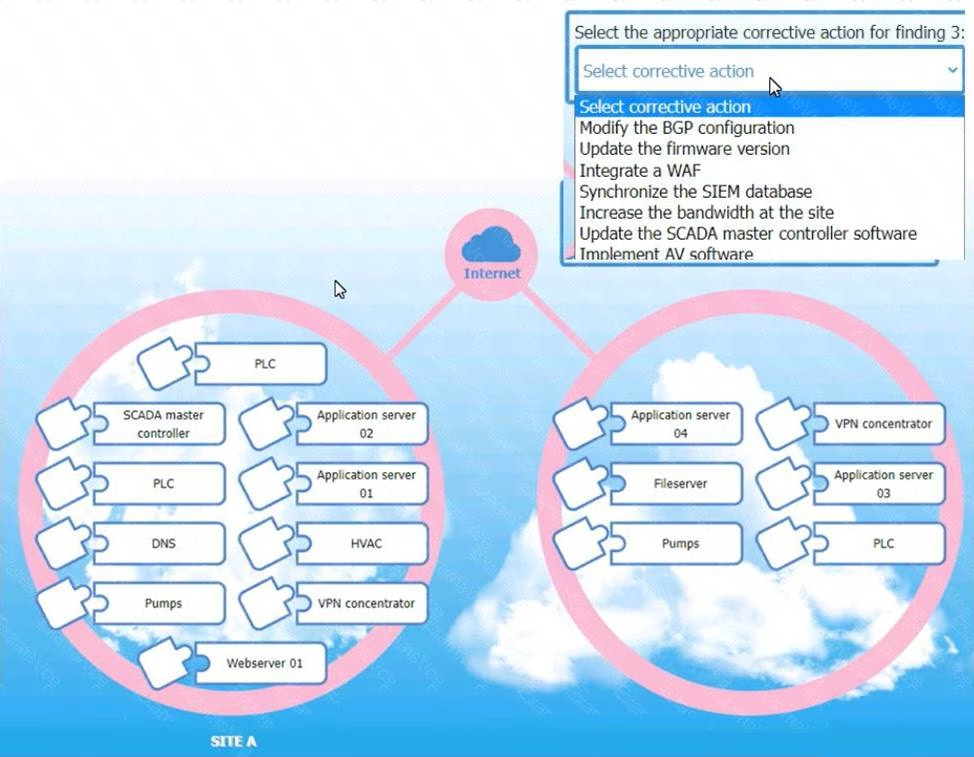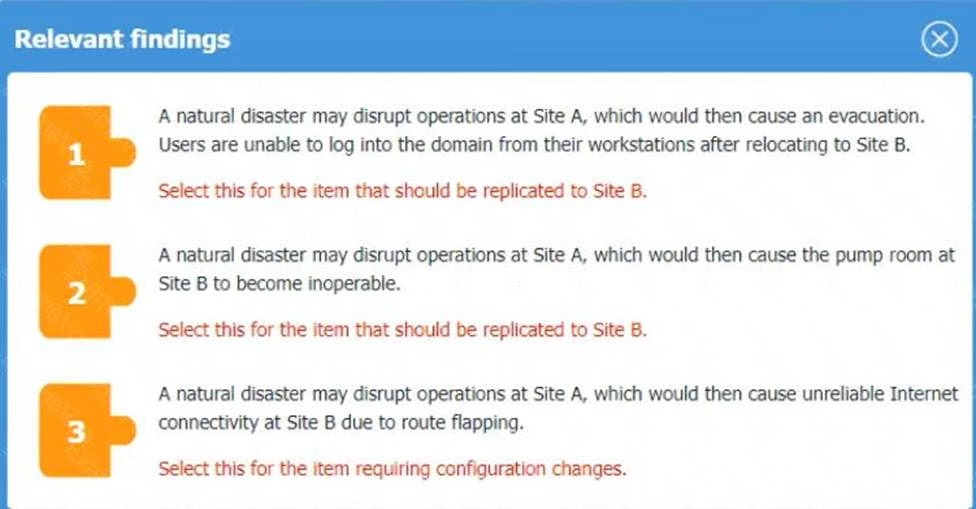A natural disaster may disrupt operations at Site A, which would then cause unreliable internet connectivity at Site B due to route flapping.
A natural disaster may disrupt operations at Site A, which would then cause unreliable internet connectivity at Site B due to route flapping.
INSTRUCTIONS
Match each relevant finding to the affected host by clicking on the host name and selecting the appropriate number.
For findings 1 and 2, select the items that should be replicated to Site B. For finding 3, select the item requiring configuration changes, then select the appropriate corrective action from the drop-down menu.


See the complete solution below in Explanation:
Answer: Matching Relevant Findings to the Affected Hosts:
Finding 1:
Affected Host: DNS
Reason: Users are unable to log into the domain from their workstations after relocating to Site B, which implies a failure in domain name services that are critical for user authentication and domain login.
Finding 2:
Affected Host: Pumps
Reason: The pump room at Site B becoming inoperable directly points to the critical infrastructure components associated with pumping operations.
Finding 3:
Affected Host: VPN Concentrator
Reason: Unreliable internet connectivity at Site B due to route flapping indicates issues with network routing, which is often managed by VPN concentrators that handle site-to-site Exams Prep connectivity.
Corrective Actions for Finding 3:
Finding 3 Corrective Action:
Action: Modify the BGP configuration
Reason: Route flapping is often related to issues with Border Gateway Protocol (BGP) configurations. Adjusting BGP settings can stabilize routes and improve internet connectivity reliability.
Replication to Site B for Finding 1:
Affected Host: DNS
Domain Name System (DNS) services are essential for translating domain names into IP addresses, allowing users to log into the network. Replicating DNS services ensures that even if Site A is disrupted, users at Site B can still authenticate and access necessary resources.
Replication to Site B for Finding 2:
Affected Host: Pumps
The operation of the pump room is crucial for maintaining various functions within the infrastructure. Replicating the control systems and configurations for the pumps at Site B ensures that operations can continue smoothly even if Site A is affected.
Configuration Changes for Finding 3:
Affected Host: VPN Concentrator
Route flapping is a situation where routes become unstable, causing frequent changes in the best path for data to travel. This instability can be mitigated by modifying BGP configurations to ensure more stable routing. VPN concentrators, which manage connections between sites, are typically configured with BGP for optimal routing.
References:
CompTIA Security+ Study Guide: This guide provides detailed information on disaster recovery and continuity of operations, emphasizing the importance of replicating critical services and making necessary configuration changes to ensure seamless operation during disruptions.
CompTIA Security+ Exam Objectives: These objectives highlight key areas in disaster recovery planning, including the replication of critical services and network configuration adjustments.
Disaster Recovery and Business Continuity Planning (DRBCP): This resource outlines best practices for ensuring that operations can continue at an alternate site during a disaster, including the replication of essential services and network stability measures.
By ensuring that critical services like DNS and control systems for pumps are replicated at the alternate site, and by addressing network routing issues through proper BGP configuration, the organization can maintain operational continuity and minimize the impact of natural disasters on their operations.
Latest CAS-005 Dumps Valid Version with 117 Q&As
Latest And Valid Q&A | Instant Download | Once Fail, Full Refund

